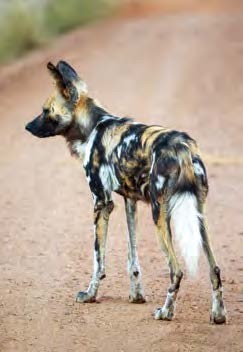
Painted Wolves
Share
African wild dogs are sometimes referred to as ‘painted wolves’. They are closely related to the black-backed jackal which is a common sight in the Pilanesberg. Both of them have conspicuous erect ears and a long muzzle that ends in a hairless fleshy area that encloses the nostrils. Bushy tails and long slender legs also count as common traits but their feeding habits are dissimilar. Unlike the black-backed jackal, the wild dog feeds entirely on flesh. Wild dogs live in packs but it sometimes happens that a wild dog is seen on its own. There may be various reasons for this. It can either be that the rest of the pack is somewhere close by, or it may be a female that has reached maturity and left its natal (birth) pack in search of other breeding opportunities. In a wild dog pack, the males stay behind to form the nucleus of the pack and the females leave to prevent inbreeding.

Within a pack there is a strict dominance hierarchy, with the dominant male and female usually the only ones to breed and lead the pack while the others help to raise the young. The pack system is crucial for efficient hunting, therefore when there are young and it’s time to hunt, only one or two dogs will remain behind to look after the litter. The rest of the pack has to provide enough food to take back to the den to feed the young and their babysitters. Submissive behaviour by the remaining dogs triggers the hunters to regurgitate the food eaten at the kill for the young and members of the pack that cannot hunt. Before a hunt, the dogs engage in play to stimulate each other for the hunt and to ensure cohesion of the group. Recent research done by Reena H Walker has revealed wild dogs have a way of communicating with each other by sneezing. When at rest and before going on a hunt, a type of democratic decision-making occurs within the pack. Votes are cast by sneezing. Once a certain number of sneezes has been reached, the pack will obey the results and move on. What is more, high-ranking individuals have to sneeze less than low-ranking ones to communicate their decision. What an extraordinary discovery this is.
This excerpt is taken from Pilanesberg Self-Drive
